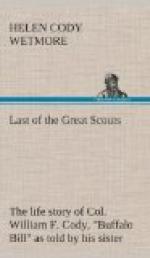One other function performed by Browne’s latinisms must be mentioned, because it is closely connected with the most essential and peculiar of the qualities which distinguish his method of writing. Certain classical words, partly owing to their allusiveness, partly owing to their sound, possess a remarkable flavour which is totally absent from those of Saxon derivation. Such a word, for instance, as ‘pyramidally,’ gives one at once an immediate sense of something mysterious, something extraordinary, and, at the same time, something almost grotesque. And this subtle blending of mystery and queerness characterises not only Browne’s choice of words, but his choice of feelings and of thoughts. The grotesque side of his art, indeed, was apparently all that was visible to the critics of a few generations back, who admired him simply and solely for what they called his ‘quaintness’; while Mr. Gosse has flown to the opposite extreme, and will not allow Browne any sense of humour at all. The confusion no doubt arises merely from a difference in the point of view. Mr. Gosse, regarding Browne’s most important and general effects, rightly fails to detect anything funny in them. The Early Victorians, however, missed the broad outlines, and were altogether taken up with the obvious grotesqueness of the details. When they found Browne asserting that ‘Cato seemed to dote upon Cabbage,’ or embroidering an entire paragraph upon the subject of ‘Pyrrhus his Toe,’ they could not help smiling; and surely they were quite right. Browne, like an impressionist painter, produced his pictures by means of a multitude of details which, if one looks at them in themselves, are discordant, and extraordinary, and even absurd.
There can be little doubt that this strongly marked taste for curious details was one of the symptoms of the scientific bent of his mind. For Browne was scientific just up to the point where the examination of detail ends, and its coordination begins. He knew little or nothing of general laws; but his interest in isolated phenomena was intense. And the more singular the phenomena, the more he was attracted. He was always ready to begin some strange inquiry. He cannot help wondering: ’Whether great-ear’d persons have short necks, long feet, and loose bellies?’ ‘Marcus Antoninus Philosophus,’ he notes in his commonplace book, ’wanted not the advice of the best physicians; yet how warrantable his practice was, to take his repast in the night, and scarce anything but treacle in the day, may admit of great doubt.’ To inquire thus is, perhaps, to inquire too curiously; yet such inquiries are the stuff of which great scientific theories are made. Browne, however, used his love of details for another purpose: he co-ordinated them, not into a scientific theory, but into a work of art. His method was one which, to be successful, demanded a self-confidence, an imagination, and a technical power, possessed by only the very greatest artists. Everyone knows Pascal’s overwhelming




